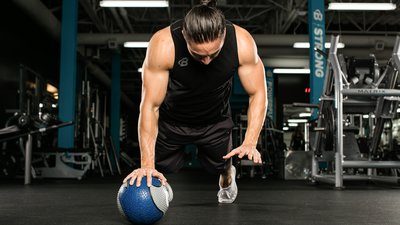The press-down is a staple movement for triceps—I've probably done more than 70,000 of them over the years—and they'll definitely add size to your arms. To keep growing, however, you have to bring fresh exercises into your training or make tweaks to your favorite moves. A 2014 study published in the Journal of Strength and Conditioning Research suggested that changing exercises is more important than loading schemes in improving muscular strength.[1]
To give you more options, we've enlisted Florida-based trainer Nick Tumminello, NSCA-CPT, owner of Performance University, and author of "Strength Training for Fat Loss, and Building Muscle and Performance." He's also a master at tweaking exercises, as you already know if you've read his articles on Bodybuilding.com or tried the True Muscle trainer he helped design.
So what's his solution? Using subtle tweaks to change the "point of maximal loading" of many common elbow-extension movements and multijoint exercises. "You can create maximal tension at different points along the ROM of any given movement," Tumminello explains. "This is easily done by adjusting the basic angles in exercises you commonly do."
As a comparison, Tumminello gives the example of transitioning from the preacher curl to a standing curl; it's a different angle that loads the muscle maximally at a different point. Here are the best triceps exercises you're not doing!
1. Angled Single-Arm Overhead Extension
Overhead extensions can be done with two hands or one, but for this version, which hammers the long head of the triceps, you'll do it unilaterally while side-lying on an incline bench. "It's basically the same exercise you do standing, but with a side lean.
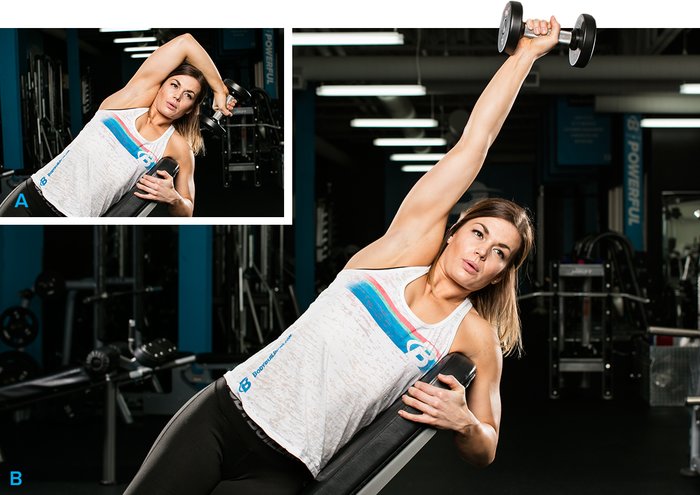
Angled Single-Arm Overhead Extension
By leaning, you change the point of maximal loading because your upper arm is no longer perpendicular to the ground," says Tumminello. "It's more angled over, which creates peak tension a little further into the contraction. You get an even better stretch when you do that as well."
Key training tip: Keep your upper arm in the same plane as the angle of the bench; if you keep it perpendicular to the floor, the point of maximal loading is too similar to the standing position, which defeats the purpose.
2. Decline-Bench Skullcrusher
You may have heard of or seen this movement. But have you tried it? Probably not. "Skullcrushers, whether using dumbbells or an EZ-bar, done off a decline bench aren't crazy new, but most people still don't include them," says Tumminello. "You're just changing the angle, and by doing so, changing the point of maximal loading. That's how you get new stimulus out of classic bodybuilding exercises."
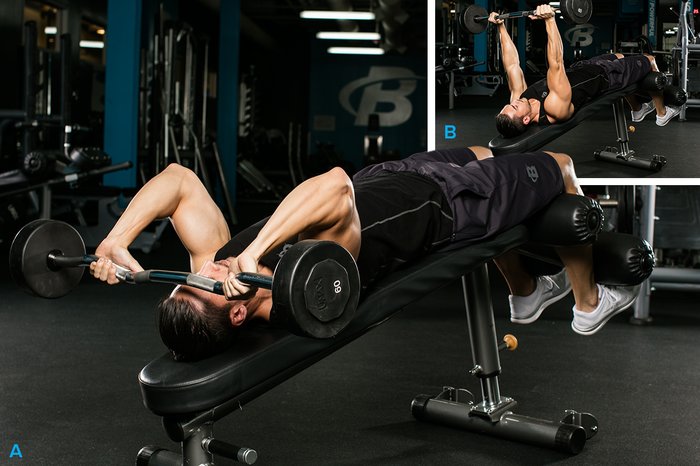
Decline-Bench Skullcrusher
Key training tip: Your upper arm should remain perpendicular to your torso, not the floor, as you adjust the angle of the bench. You can use multiple decline positions to slightly alter the point of emphasis each time. Of course, you could try it with an incline as well.
3. Incline Close-Grip Bench Press
The close-grip bench press is a tried-and-true way to add some intensity to the start of an arm workout. You can move heavier loads with it than almost any other triceps move, but you're definitely not limited to a flat bench. As with the decline skullcrusher, you can use an incline bench to provide new stimulus.
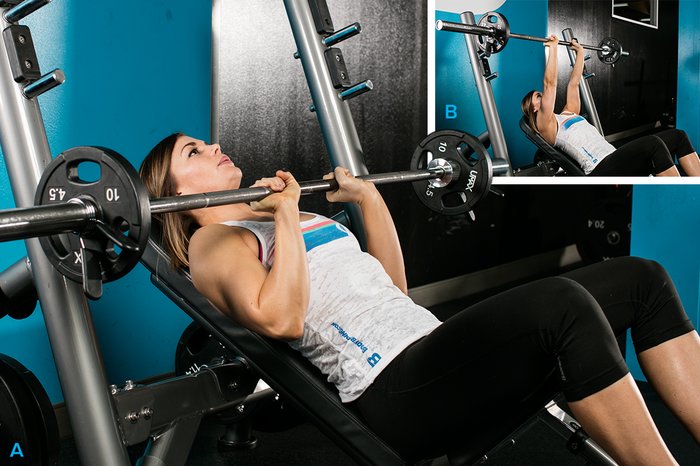
Incline Close-Grip Bench Press
Key training tip: Keep your arms perpendicular to your torso, not the floor, to reap the benefits of the incline bench. Again, with adjustable benches, you can utilize multiple incline positions, each just a bit different from the others.
4. Cable Skullcrusher
While most of us do skulls with free weights, switching over to cables offers a distinct change: Instead of working against gravity, the line of pull is coming from down and to the side when you use lower cables. You can even adjust the height of the pulley to alter the angle as well.
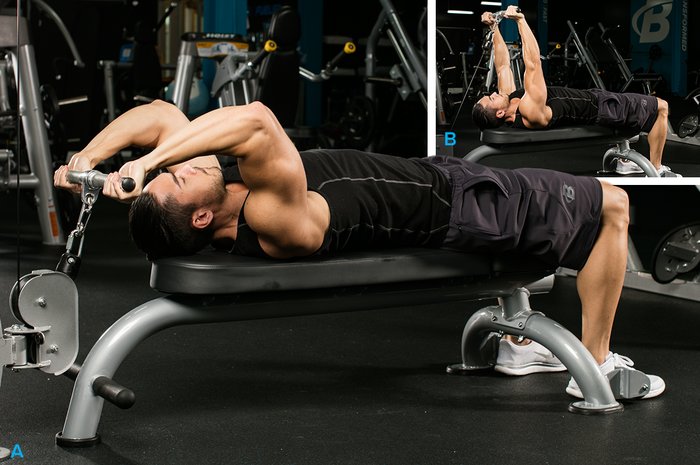
Cable Skullcrusher
Key training tip: Try performing this cable move on an incline or decline bench.
5. Cable Kick-Back
As with the skullcrusher, using a cable changes the angle of pull, keeping tension on the muscle from the beginning of the range of motion to the end. Start by positioning the cable at its lowermost position, then try different angles over time.
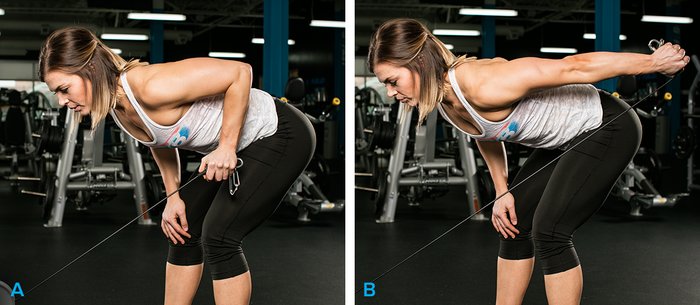
Cable Kick-Back
In addition, if you take off the handle and grasp the rubber ball on the cable between your thumb and index finger, you can use a neutral hand position, where the lateral head gets most of the work. Supinate a little more and you'll have an underhand grip, which shifts the emphasis more to the medial head.
Key training tip: If you drop your elbow as you lower the weight, this single-joint movement becomes a multijoint one, which takes stress off the triceps. Keep that upper arm up beside your body for the duration of the set.
6. Push-Up Lock-Off
Tumminello says this is one of his favorites. Start in a push-up position with one hand elevated slightly, such as on an aerobic step, and the other hand on the floor. Descend in the normal manner, and then come up.
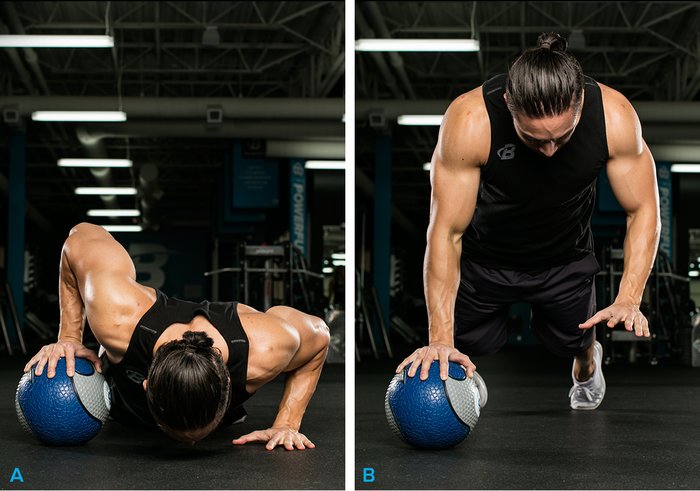
Push-Up Lock-Off
Here's where it departs from a normal push-up: You're going to continue the elbow extension of the elevated hand until your arm is fully extended, which brings your lower hand completely off the floor. "That dramatically increases the workload on the triceps of the working arm, not only because it's stabilizing your shoulder, but also because it's maintaining your body position," explains Tumminello. "There's even a bit of core work involved as you maintain your body alignment."
Key training tip: "You can perform this with either a Reebok step or a small medicine ball, though I'd go no higher than about an 8-pound ball," Tumminello says. Using a medicine ball is more difficult than the step bench because it's more unstable. Also, putting your feet up on a bench increases the workload done by the upper-body musculature even more.
7. Single-Arm Reverse-Grip Cable Concentration Push-Down
The name is a mouthful, but the move itself isn't too complicated. Think of it as a single-arm cable concentration curl, only done in reverse.
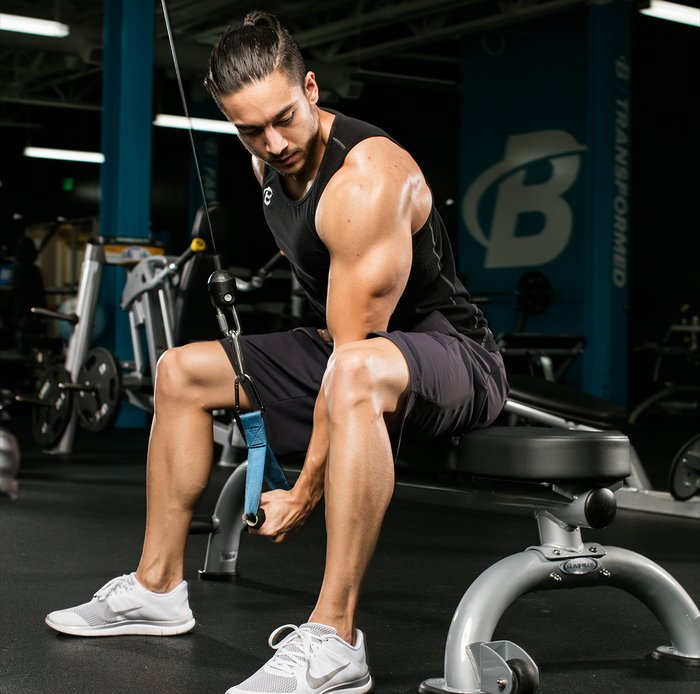
Single-Arm Reverse-Grip Cable Concentration Push-Down
You can perform this medial-head-emphasis movement standing, or seated with the working arm pressed against your inner thigh for greater isolation. Either way, it's definitely one for the end of your workout, because you won't be able to use much weight.
Key training tip: Use the top pulley position for the cable. If you're using a bench, you may need to adjust it to ensure your triceps stay pressed against your inner thigh. Don't be afraid to do some forced reps with your free hand at the end of your set.
References
- Fonseca, R. M., Roschel, H., Tricoli, V., de Souza, E. O., Wilson, J. M., Laurentino, G. C., ... & Ugrinowitsch, C. (2014). Changes in exercises are more effective than in loading schemes to improve muscle strength. The Journal of Strength & Conditioning Research, 28(11), 3085-3092.



